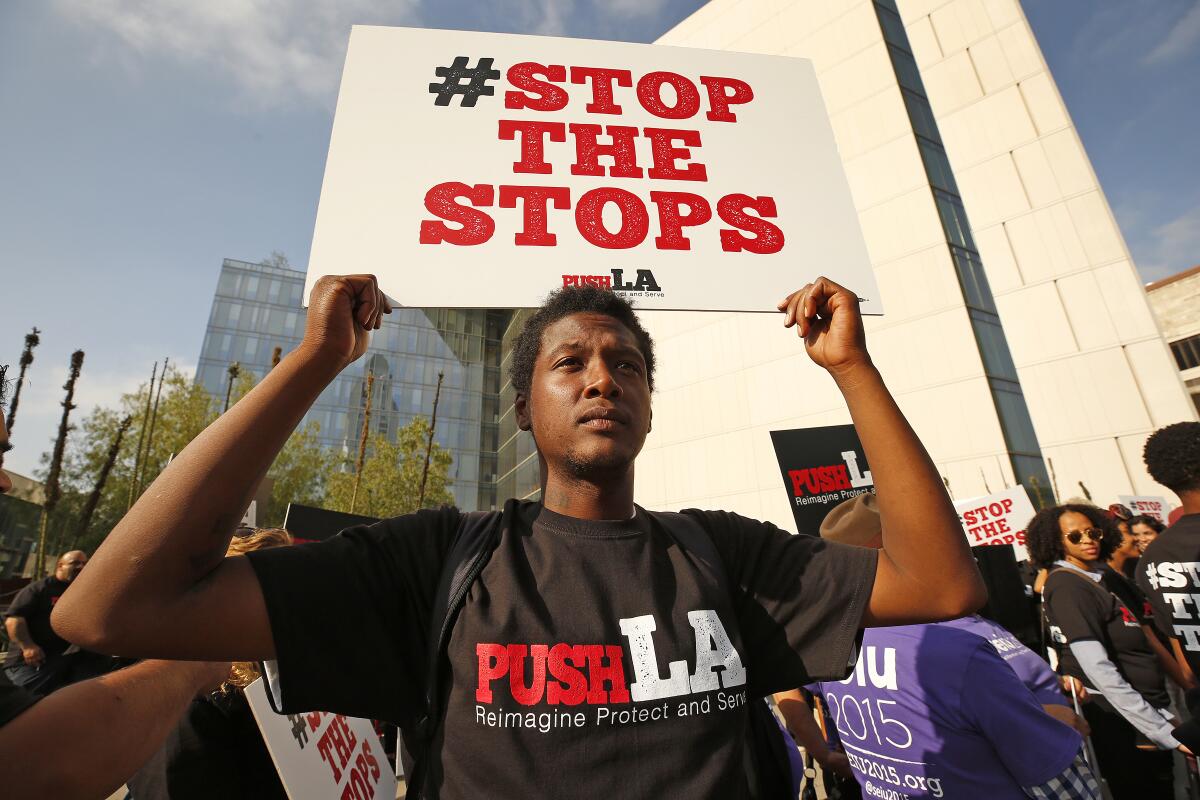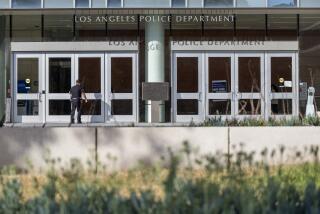Editorial: Think carefully before rolling back LAPD on traffic and other duties

- Share via
If the time expires on your parking meter and you’re not there to move your car (or to surreptitiously pump in a few more quarters), there’s a good chance you’re going to get a ticket. In Los Angeles, that unpopular but necessary work is performed by efficient, uniformed, badged but decidedly unarmed traffic officers. The same people — employees of the city’s Department of Transportation — direct traffic when signals fail and arrange to tow abandoned cars.
But they don’t handle moving violations. They don’t pull you over for failing to signal, and they don’t hand out speeding tickets. On city streets, that job generally falls to the Los Angeles Police Department, which has acquired a reputation for discriminatory and pretextual stops, disproportionately aimed at Black and Latino drivers. Police ostensibly do traffic enforcement, but there have been periods in which their mission has been to find a reason to stop cars in order to search them for contraband — sometimes drugs but more often illegal weapons, especially during upswings in homicides and other violent crimes.
In some parts of town, being pulled over by the LAPD means getting a ticket. In others, though, especially when the driver is a young Black man, being pulled over often means being removed from the car, sometimes at gunpoint, and being ordered to sit on the curb or being splayed prone on the asphalt while the officer asks “permission” to search the vehicle.
It’s similar in most U.S. cities large and small, where streets are patrolled by armed police. The most notorious recent case may be the killing of Philando Castile, a Black motorist pulled over in a Minneapolis suburb in 2016. Castile properly told the police officer there was a gun in the car to ensure the cop did not panic and turn violent if he saw it; the officer shot Castile to death anyway.
Black drivers, especially, know that any police stop has the potential to turn deadly. Traffic stops put Black communities in a vise, crushing them between violent crime, from which residents desperately seek relief, and the police, who are there to stop the crime but too often add their own brand of oppression.
Los Angeles City Councilman Marqueece Harris-Dawson and several of his colleagues are calling for city officials to explore alternatives. Why, they want to know, shouldn’t traffic patrol be handled instead by the same folks who write parking tickets and direct traffic? Why shouldn’t unarmed officers also handle drunk drivers, traffic accidents, Metro fare evaders and similar matters?
They have asked these questions in response to the demands of protesters following the killing of George Floyd in Minneapolis on May 25. Floyd wasn’t pulled over in a traffic stop, but his death has properly sparked a reevaluation of every aspect of policing.
They are the right questions, and the council members are seeking the right response: a thorough study of the city’s resources and options. To their credit, they are also listening to their constituents, including organizers pushing to deeply cut the LAPD budget.
The council would be wise to resist the temptation to skip the study and move headlong into a change that would pull police off the street and put in their place traffic officers who aren’t yet trained for the duty. Some cities are more directly heeding calls to “defund” their police and put unarmed personnel in their place. But we got into the current mess with knee-jerk responses to high-profile outrages.
Consider, for example, the 1993 killing of Polly Klaas, which led to excessive sentences for non-killers, or other crimes that sparked ill-considered initiatives like arming police with military-grade equipment and training them to be occupying forces in crime-ravaged communities. It would be foolish, and counterproductive, to now overreact in the opposite direction and precipitously cut police without thinking through the consequences.
City officials should keep in mind the difference between ticketing a parked car and stopping a driver who failed to signal before turning left. The first instance involves no face-to-face encounter. The second does, and such encounters always include the possibility of confrontation. Unarmed traffic officers work well in many other nations, where the people they stop likewise are unarmed. Here, though, there are more deadly weapons than there are people. That unfortunate fact is what puts so many armed police in the position of handling what ought to be administrative, social or health problems.
Police are the wrong first responders to send when people are experiencing psychiatric breakdowns or drug overdoses, but mental health and public health workers are often understandably reluctant to take on the job without police backup for fear of violence. By the same token, would an unarmed traffic officer untrained in confrontation (and deescalation) be afraid to pull over a car with blacked-out windows? Would there be police backup, and if so would the situation wind up any different than it does now? Can we reasonably project, based on evidence, a decline in violent police encounters without an increase in danger to traffic officers and other unarmed personnel? It’s time to put the city to work studying these questions and providing answers.
More to Read
A cure for the common opinion
Get thought-provoking perspectives with our weekly newsletter.
You may occasionally receive promotional content from the Los Angeles Times.










